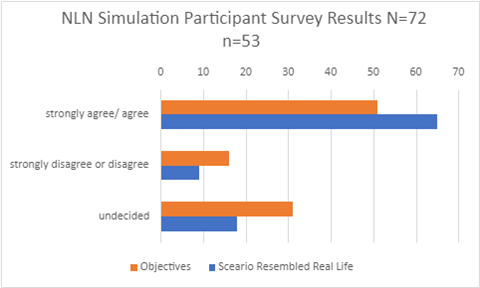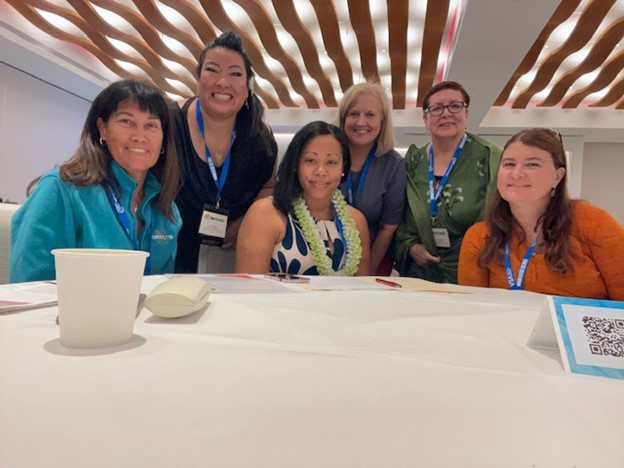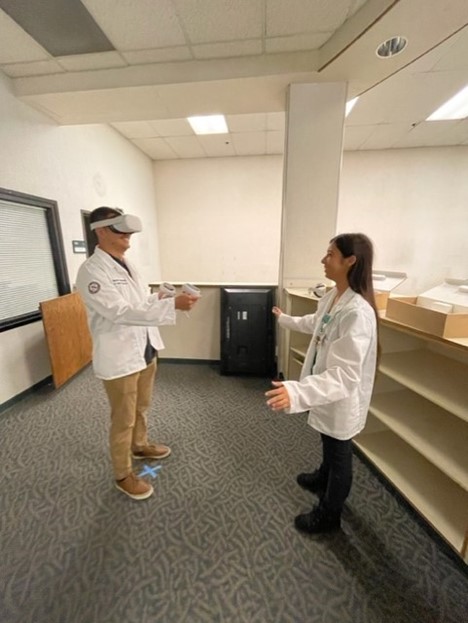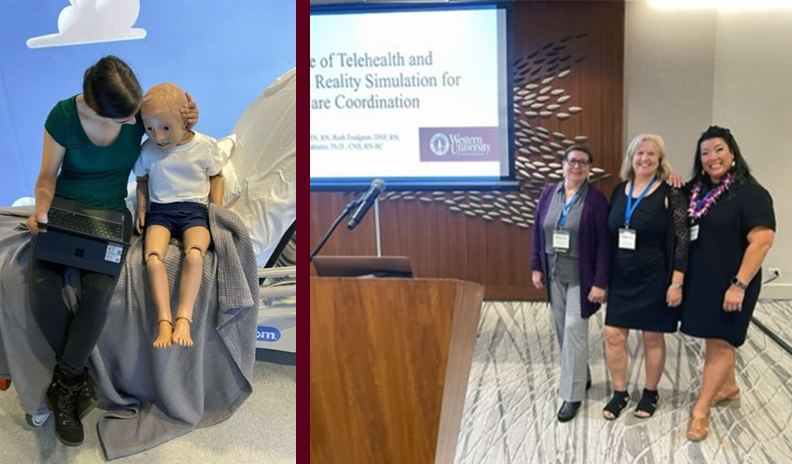Agency for Healthcare Research and Quality (2016) “deliberately organizing patient care activities and sharing information among all of the participants concerned with a patient’s care to achieve safer and more effective care.” Teamwork and management along with communication align resources for optimal patient outcomes.
The College of Graduate Nursing (CGN), Master of Science in Nursing Entry (MSNE) program faculty, Linda Flores, MSN, RN, Dr. Ruth Trudgeon, and Dr. Patricia Shakhshir shared a podium to present at the California Simulation Alliance, the Hawai’i State Simulation Collaborative, and the Victorian Simulation Alliance Inaugural Transpacific Simulation Alliance Event for 2023. Set in beautiful Hawai’i. CGN faculty discussed innovations, learnings, and research in telehealth and virtual reality simulation in care coordination.
Moving learning experiences beyond the classroom and into the simulation center, 72 second year MSNE care coordination students deliberately organized patient care activities, shared information among simulated care participants, and achieved safer more effective care outcomes. According to Kang et al., (2020), nurses received no formal training on care coordination. Courses and simulations in care coordination at CGN hope to close this practice gap.
The telehealth care coordination simulations specifically utilized teamwork communication from TEAMSTEPPS (AHRQ, 2020) framework for CUS, the two-challenge rule for addressing an essential safety breach and offering alternatives, learned from WUHS and Kaiser Permanente Interprofessional Educational Courses. The virtual reality (VR) simulations enabled participants to conduct assessments on the unhoused patient and their environment. The VR adaptive learning capabilities allowed participants to assess, prioritize patient concerns, and coordinate care for the safety of the patient.
After simulation, students completed the simulation design scale (NLN, 2005) survey: 65% agreed and strongly agreed the scenario resembled real life situation with variables built into the simulation scenario. 9% disagreed or strongly disagreed. 18% undecided. 51% agreed and strongly agreed objectives, information, and cues were sufficient to problem solve. 16% disagreed or strongly disagreed. 31% were undecided. Based on the evaluation tool, a longer pre-briefing on the scenario and a sample of a discharge plan for post brief for students to model may facilitate improvement of their perception of the care coordination simulation. This was their inaugural care coordination simulation in 2nd year of their MSNE program.

Overall, the conference emphasized measurable outcomes from simulations. Simulation scenario improvement should be based on validated surveys and tools. CGN shared two care coordination simulations to move the experiential learning needle forward beyond the classroom. Shared knowledge for collective wisdom will ultimately grow our next generation into quality, safe, and person-centered care providers. Closing the care coordination nursing education to practice gap using simulation is viable and feasible.



References
Agency for Healthcare Research and Quality. (2016). Care coordination. Retrieved from http://www.ahrq.gov/professionals/prevention-chronic-care/improve/coordination/i[Context Link]
Agency for Healthcare Research and Quality. (2020, January). Pocket Guide: TeamSTEPPS. Rockville, MD.
https://www.ahrq.gov/teamstepps/instructor/essentials/pocketguide.html
Kang E., Tobiano G.A., Chaboyer W., Gillespie B.M. (2020). Nurses’ role in delivering discharge education to general surgical patients: A qualitative study. Journal of Advanced Nursing, 6(7):1698–1707. doi: 10.1111/jan.14379


